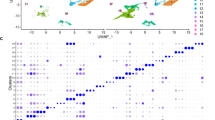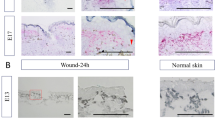Abstract
The early fetus responds to cutaneous wounds in a fundamentally different way from the adult; fetal wounds heal without scars. Wound contraction is a vital component of wound healing. The cytokine transforming growth factor(TGF)-β promotes wound contraction and can be activated by the serine protease plasmin. Herein, we explored whether murine skin fibroblast contractile properties, TGF-β, and plasmin formation are developmentally regulated. Our results showed that early fetal mouse embryonic day 15 skin fibroblasts contracted a collagen gel less, secreted less active and total TGF-β, and generated less plasmin than either late fetal (embryonic day 17) or adult skin fibroblasts. Furthermore, there was a slight positive correlation between the formation of plasmin and the level of activation of TGF-β. We conclude that early fetal mouse skin fibroblasts contract a collagen gel and secrete and activate TGF-β to a lesser extent than do late fetal and adult skin fibroblasts. We speculate that the fetal skin fibroblast undergoes a developmental transition that causes wounds in mouse to contract at or after embryonic day 17. Further, this developmental transition is influenced by growth factor-fibroblast interactions and coincides with the emergence of the skin fibroblast's ability to generate plasmin and activate TGF-β.
Similar content being viewed by others
Log in or create a free account to read this content
Gain free access to this article, as well as selected content from this journal and more on nature.com
or
Abbreviations
- TGF-β:
-
transforming growth factor-β
- DMEM:
-
Dulbecco's modified Eagle's medium
- PAI:
-
plasminogen activator inhibitor
- PA:
-
plasminogen activator
- PDGF:
-
platelet-derived growth factor
- E15, E17:
-
embryonic day 15, 17
References
McCallion RL, Ferguson MW 1996 Fetal wound healing and the development of antiscarring therapies for adult wound healing. In: Clark RA (ed) The Molecular and Cellular Biology of Wound Repair. Plenum, New York, pp 561–600
Adzick SN, Lorenz HP 1994 Cells, matrix, growth factors, and the surgeon: the biology of scarless fetal wound repair. Ann Surg 220: 10–18
Lorenz HP, Whitby DJ, Longaker MT, Adzick NS 1993 Fetal wound healing: the ontogeny of scar formation in the non-human primate. Ann Surg 217: 391–396
Lorenz HP, Lin RY, Longaker MT, Whitby DJ, Adzick NS 1995 The fetal fibroblast: the effector cell of scarless fetal skin repair. Plast Reconstr Surg 96: 1251–1261
Grinnell F 1994 Fibroblasts, myofibroblasts and wound contraction. J Cell Biol 124: 401–404
Clark RA 1993 Regulation of fibroplasia in cutaneous wound repair. Am J Med Sci 306: 42–48
Estes JM, Van de Berg JS, Adzick NS, MacGillivray TE, Desmouliere A, Gabbiani G 1994 Phenotypic and functional features of myofibroblasts in sheep wounds. Differentiation 56: 173–181
Longaker MT, Burd AR, Gowen AH, Yen TS, Jennings RW, Duncan BW, Harrison MR, Adzick NS 1991 Midgestational excisional fetal lamb wounds contract in utero. J Pediatr Surg 26: 942–948
Montesano R, Orci L 1988 Transforming growth factor-β stimulates collagen-matrix contraction by fibroblasts: implications for wound healing. Proc Natl Acad Sci USA 85: 4894–4897
Piscatelli SJ, Michaels BM, Gregory P, Jennings RW, Longaker MT, Harrison MR, Siebert JW 1994 Fetal fibroblast contraction of collagen matrices in vitro: the effects of epidermal growth factor and transforming growth factor-β. Ann Plast Surg 33: 38–45
Krummel TM, Michna BA, Thomas BL, Sporn MB, Nelson JM, Salberg AM, Cohen IK, Diegelmann RF 1988 Transforming growth factor β(TGFβ) induces fibrosis in a fetal wound model. J Pediatr Surg 23: 647–652
Sullivan KM, Lorenz HP, Meuli M, Lin RY, Adzick NS 1995 A model of scarless human fetal wound repair is deficient in transforming growth factor. J Pediatr Surg 30: 198–203
Whitby DJ, Ferguson MW 1991 Immunohistochemical localization of growth factors in fetal wound healing. Dev Biol 147: 207–215
Longaker MT, Bouhana KS, Harrison MR, Daneilpour D, Roberts AB, Banda MJ 1994 Wound healing in the fetus: possible role for inflammatory macrophages and transforming growth factor-β isoforms. Wound Repair Regul 2: 104–112
Lin RY, Sullivan KM, Argenta PA, Meuli M, Lorenz HG, Adzick NS 1995 Exogenous transforming growth factor-beta amplifies its own expression and induces scar formation in a model of human fetal skin repair. Ann Surg 222: 146–154
Martin P, Dickson MC, Millan FA, Akhurst RJ 1993 Rapid induction and clearance of TGF β1 is an early response to wounding in the mouse embryo. Dev Genet 14: 225–238
Roberts AB, Sporn MB 1995 Transforming growth factor-β. In: Clark RA (ed) The Molecular and Cellular Biology of Wound Repair. Plenum, New York, pp 275–308
Clark RA, Nielsen LD, Welch MP, McPherson JM 1995 Collagen matrices attenuate the collagen synthetic response of cultured fibroblasts to TGFβ. J Cell Sci 108: 1251–1261
Ignotz RA, Massague J 1986 Transforming growth factor-β stimulates the expression of fibronectin and collagen and their incorporation into extracellular matrix. J Biol Chem 261: 4337–4340
Roberts AB, Sporn MB, Assoian RK, Smith JM, Roche MS, Heine UF, Liotta L, Falanga V, Kehrl JH, Fauci AS 1986 Transforming growth factor beta: rapid induction of fibrosis and angiogenesis in vivo and stimulation of collagen formation. Proc Natl Acad Sci USA 83: 4167–4171
Miyazono K, Ichijo H, Heldin CH 1993 Transforming growth factor-β: latent forms, binding proteins and receptors. Growth Factors 8: 11–22
Harpel JG, Metz CN, Kojima S, Rifkin DB 1992 Control of transforming growth factor-β activity: latency vs. activation. Prog Growth Factor Res 4: 321–335
Guidry C, Grinnell F 1987 Heparin modulates the supramolecular organization of hydrated collagen gels and inhibits gel contraction by fibroblasts. J Cell Biol 104: 1097–1103
Nakagawa S, Pawalek P, Grinnell F 1989 Extracellular matrix organization modulates fibroblast growth and growth factor responsiveness. Exp Cell Res 182: 572–582
Tuan TL, Grinnell R 1989 Fibronectin and fibrinolysis are not required for fibrin gel contraction by human skin fibroblasts. J Cell Physiol 140: 577–583
Abe M, Harpel JG, Metz CN, Loskatoff DJ, Rifkin DB 1994 An assay for transforming growth factor-β using cells transfected with a plasminogen activator inhibitor-1 promoter-luciferase construct. Anal Biochem 216: 276–284
Khalil N, Corne S, Whitman C, Yacyshyn H 1996 Plasmin regulates the activation of cell-associated latent TGF-β1 secreted by alveolar macrophages after in vivo bleomycin injury. Am J Respir Cell Mol Biol 15: 252–259
Newman PJ 1997 Cell adhesion in vascular biology: the biology of PECAM-1. J Clin Invest 99: 3–8
Hallock GG, Merkel JR, Rice DC, DiPaolo BR 1993 The ontogenetic transition of collagen deposition in rat skin. Ann Plast Surg 30: 239–243
Hendrick MJ, Rice HE, Vander Wall KJ, Adzick NS, Harrison MR, Siebert J, Hoffman WY, Longaker MR 1996 Delayed in utero repair of surgically created fetal cleft lip and palate. Plast Reconstr Surg 97: 900–907
Freedland M, Karmiol S, Rodriguez J, Normolle D, Smith D, Garner W 1995 Fibroblast responses to cytokines are maintained during aging. Ann Plast Surg 35: 290–296
Longaker MT, Whitby DJ, Ferguson MW, Lorenz HP, Harrison MR, Adzick NS 1994 Adult skin wounds in the fetal environment heal with scar formation. Ann Surg 219: 65–72
Ihara S, Motobayashi Y, Nagao E, Kistler, A 1990 Ontogenetic transition of wound healing pattern in rat skin occurring at the fetal stage Development 110: 671–680
Whitby DJ, Ferguson MW 1991 The extracellular matrix of lip wounds in fetal, neonatal and adult mice. Development 112: 651–668
Lyons RM, Keski-Oja J, Moses HL 1988 Proteolytic activation of latent transforming growth factor-β from fibroblast conditioned medium. J Cell Biol 106: 1659–1665
Vassalli JD, Sappino AP, Belin D 1991 The plasminogen activator/plasmin system. J Clin Invest 88: 1067–1072
Plow EF, Freaney DE, Pescia J, Miles LA 1986 The plasminogen system and cell surfaces: evidence for plasminogen and urokinase receptors on the same cell type. J Cell Biol 103: 2411–2420
Nachtigal MW, Ingraham HA 1996 Bioactivation of mullerian inhibiting substance during gonadal development by kex2/subtilisin-like endoprotease. Proc Natl Acad Sci USA 93: 7711–7716
Clark RA, Folkvord JM, Hart CE, Murray MJ, McPherson JM 1989 Platelet isoforms of platelet-derived growth factor stimulate fibroblasts to contract collagen matrices. J Clin Invest 84: 1036–1040
Haynes JH, Johnson DE, Mast BA, Diegelmann RF, Salzberg DA, Cohen IK, Krummel TM 1994 Platelet-derived growth factor induces fetal wound fibrosis. J Pediatr Surg 29: 1405–1408
Acknowledgements
The authors thank Judy Zhu for excellent technical assistance, Earl Leonard for assistance in the statistical analysis of the data, and Dr. Daniel Rifkin of New York University of for the generous gift of PAI-1-transfected mink lung epithelial cells.
Author information
Authors and Affiliations
Additional information
Supported by a Childrens Hospital Los Angeles Research Institute Career Development Award (to C.L.C.) and by National Institutes of Health Grants HL44060 and HL4977 (to D. W.) and AR40409 (to T.-L.T.).
Rights and permissions
About this article
Cite this article
Coleman, C., Tuan, TL., Buckley, S. et al. Contractility, Transforming Growth Factor-β, and Plasmin in Fetal Skin Fibroblasts: Role in Scarless Wound Healing. Pediatr Res 43, 403–409 (1998). https://doi.org/10.1203/00006450-199803000-00016
Received:
Accepted:
Issue date:
DOI: https://doi.org/10.1203/00006450-199803000-00016
This article is cited by
-
Cell morphology and mechanosensing can be decoupled in fibrous microenvironments and identified using artificial neural networks
Scientific Reports (2021)
-
The Contractile Phenotype of Dermal Fetal Fibroblasts in Scarless Wound Healing
Current Pathobiology Reports (2017)



